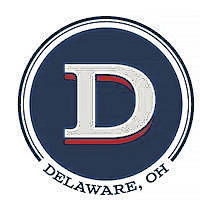
In February, Delaware City Council and City Engineer Bill Ferrigno discussed traffic volume concerns brought forward by residents in the Hull Drive community. During the discussion, Ferrigno suggested various “passive” traffic calming measure such as adding a traffic-calming island in the middle of the road, decreasing the width of lanes, and adding lines, all of which Ferrigno said would force drivers to slow down because the measures would “increase their perception of risk.”
Follow that discussion, Ferrigno requested a three-month window to further research a passive guidance policy to be an extension of the city’s traffic calming policy. During Monday’s meeting of Delaware City Council, Ferrigno expanded on those options as part of the Public Works Department’s presentation on its “Traffic Calming Guide for Neighborhood Streets.”
Ferrigno talked about the two types of traffic calming measures — intrusive and non-intrusive — and what they entail. Non-intrusive measures include signage, striping and narrowing of lanes, chicanes, physical curb bump-outs, and speed bumps.
Intrusive measures are meant to divert traffic off a road or in a particular direction. Such measures include physical barriers such as right-turn-only barriers or splitter islands that restrict vehicles from continuing in a certain direction.
Ferrigno said the non-intrusive measures would typically be implemented when the 85th percentile speeds are being measured at least five miles per hour over the posted speed limit. The 85th percentile is a national standard and defines the speed that 85 percent of drivers will drive at or below under free-flowing conditions. Prior to that, the traffic calming guide suggests public encouragement, yard sign campaigns, and enhanced crosswalks as measures that could be enacted while that percentile still sits between zero and five miles per hour over the limit.
According to the report included in the guide, Hull Drive has an average daily traffic count of 2,472 cars, traveling at an average speed of just over 26 miles per hour. The 85 percentile speed is shown as 29 miles per hour. While the traffic count is the second highest volume recorded by the city during their studying of collector roads, the average speed and 85th percentile speeds are well below several other roads the city observed.
Ferrigno said striping for roads to narrow the lanes cost about $6,000 to $8,000, but it would be something the residents should have to pay for at this time given that their data suggests there isn’t any sort of crisis along Hull Drive.
“I think the important idea to recognize is, based on the current speeds, it would be a minor (solution), and we wouldn’t recommend the city paying for it,” Ferrigno said.
Like the conversations before, there is still confusion on what residents and the city are looking to change. While the conversations began as a discussion on the high traffic volumes on Hull Drive, the traffic calming measures would only help in slowing cars down and have little to no impact on the amount of cars.
Referencing the city’s studies that show other roads to be facing more pressing speed concerns, Councilwoman Lisa Keller asked, “What makes one neighborhood or one street jump ahead of 15 other streets that would qualify more?”
City Manager Tom Homan said, “I think, in this case, you have a neighborhood who has been, for the last year and a half, been coming before Parking and Safety (Committee), making the requests … striping is a possibly effective way of helping out with the speed issue.”
“But what is the speed issue we’re trying to solve,” Keller rebutted. “Because we don’t have a significant speed issue on Hull Drive … that’s where I feel like we’re meandering. Are we solving a speed problem or a number of vehicles problem? Striping the road won’t stop the number of cars from going down the street. So, we’ll spend the money, and then we’ll still have 4,000 cars.”
Keller later said she would support striping or similar measures if the neighborhood was willing to pay for it, adding, “Unless there is a significant documented problem. And I think we have a whole bunch of significant documented problems that would take precedence. And I think for the city to pay for it and skip down the list (of roads with speed issues) is a very questionable thing to do.”
Ferrigno said the city is in the process of trying to recapture the data points again to offer a better assessment of what roads truly have the most pressing traffic issues, whether that be in terms of volume or speed.


